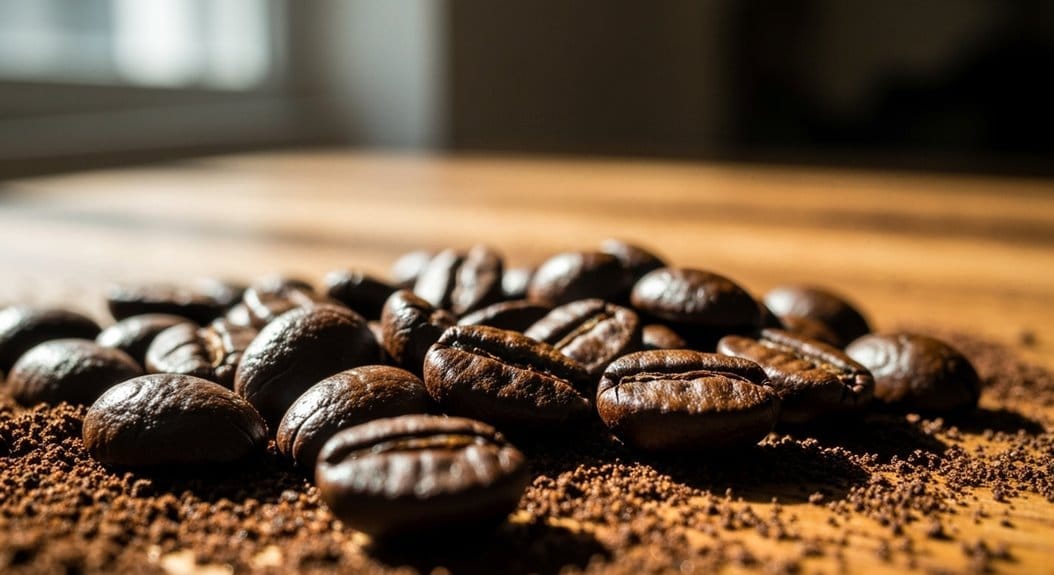So, coffee comes in three awesome roasts: light, medium, and dark! Light roasts are like a fruity surprise party in your mouth, bursting with flavor (and caffeine!). Medium roasts? They’re the Goldilocks of coffee—just right, with sweet and caramel notes to balance things out. And then there’s dark roast, which is like a cozy blanket of chocolatey goodness, perfect for chilly mornings. Each blend fits a mood, or maybe your coffee-spilling mishaps! Stick around and uncover more delightful sips!
Key Takeaways
- Light roast features a fruity and floral flavor, higher caffeine content, and is best brewed with pour-over or Aeropress methods.
- Medium roast offers a balanced flavor profile with caramel notes, suitable for various brewing methods like drip and AeroPress.
- Dark roast presents a bold bittersweet taste, smooth texture, and low acidity, providing comfort with each sip.
- The choice of brewing method significantly influences the flavor extraction of each roast type.
- Personal coffee preferences can vary based on context, with each roast catering to different taste profiles.
Light Roast
As for coffee roasts, you might think all coffee is the same—but, boy, oh boy, are you in for a surprise!
Light roast coffee is like the bright-eyed overachiever of the coffee world—light brown, no oily surface, and bursting with flavor nuances! Roasted at lower temps, these beans keep their fruity and floral goodness intact, making them perfect for those who truly appreciate coffee. Unlike darker roasts, light roasts contain higher caffeine content, which can give you that extra buzz you didn’t expect! Additionally, a black cup of blonde roast coffee can average about 95mg of caffeine per 8-ounce serving, further highlighting its caffeine richness. This style of roasting allows the natural mutations of the coffee beans to shine through, emphasizing their unique flavor profiles.
When brewed using methods like pour-over or Aeropress, it showcases those bright, vibrant flavors. And here’s a fun fact—light roasts have more caffeine than you’d think!
Medium Roast
Coffee lovers can’t just pick one roast and call it a day—there’s a whole universe of flavors and styles out there!
Enter the medium roast, the jack-of-all-trades in the coffee domain. With a lovely medium-brown color, it sidesteps the oiliness of those darker roasts, bringing flavor complexity to the forefront. Imagine a smooth cup, hinting at caramel and sweet notes without making your taste buds throw in the towel! Medium roasts can also be crafted from a variety of Arabica coffee beans, which are known for their nuanced flavors and aromas.
This roast works beautifully with diverse brewing methods, whether you’re drip-brewing or going fancy with an AeroPress. Plus, it plays nice with milk—just like that friend who can mingle at any party! Additionally, medium roasts are often chosen for their balanced extraction that allows the inherent flavors to shine through without overpowering each other.
Dark Roast

Dark roast—oh boy, it’s like a cozy blanket on a chilly day! This coffee, with its dark brown to nearly black beans, packs a punch that’ll wake you up faster than a surprise fire drill.
Dark roast coffee is your warm hug in a cup, energizing you with its bold flavor and cozy vibes!
The roasting process cranks it up to high heat—think 430 to 450°F—where the beans crack and release those delicious surface oils.
Here’s what to expect from a dark roast:
- Bold bittersweet flavor, like chocolatey goodness!
- A smooth texture that’s rich as heavy cream.
- Aroma vibes of smoky caramel and toasted nuts.
- Low acidity means no bitter aftertaste, yay!
With dark roast coffee, each sip gives you comfort, like a warm hug with a side of caffeine!
Frequently Asked Questions
What Roast Is Best for Espresso Preparation?
Medium to dark roasts are best for espresso preparation, as they improve espresso characteristics and provide balanced flavor profiles. Medium roasts offer versatility, while dark roasts deepen flavors, particularly beneficial in milk-based espresso drinks.
Do Roast Levels Affect Caffeine Content in Coffee?
Roast levels minimally affect caffeine content in coffee, reinforcing caffeine myths. Roast differences largely influence flavor rather than caffeine. Actual caffeine intake depends more on bean weight and brewing method than the roast level itself.
How Should I Store Roasted Coffee Beans?
To store roasted coffee beans effectively, use airtight storage containers that limit air and light exposure, promoting freshness longevity. Dark, cool places are ideal, and smaller, frequent purchases help maintain peak flavor over time.
Can I Blend Different Roast Levels for Unique Flavors?
Yes, blending different roast levels creates unique flavor profiles. Combining light, medium, and dark roasts can yield complex tastes, balancing acidity and body, while post-roast methods enable precise adjustments for ideal flavor harmony in each blend.
What Brewing Methods Suit Each Roast Type Best?
Brewing techniques vary by roast type, with light roasts favoring pour-over for delicate flavor extraction, medium roasts adaptable across methods for balanced profiles, and dark roasts benefitting from immersion methods to improve robust, rich flavors.





